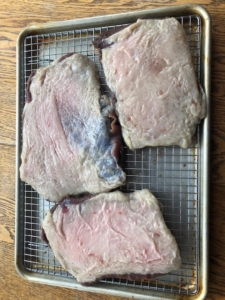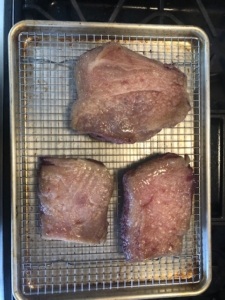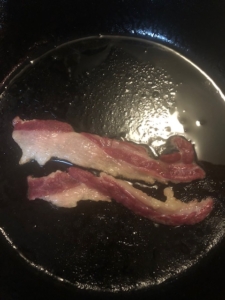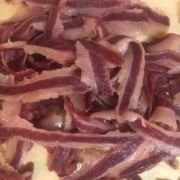Bear Bacon
Ken took a fine bear on the second to last day of the season. And as we sat in camp that night and took it in – that mixture of disbelief and gratitude that hunters feel in the wake of success – talk turned to bear bacon.
You’ll find references to bear bacon in the historical record, but in many cases the phrase seems to refer to cured and smoked bear ham (i.e. hindquarter). We wanted to make it with sidemeat – as if the bear were a pig. The 250 pound liveweight was roughly equivalent to the weight at which you might slaughter a hog, but of course the animals are built very differently. Bears are like outside linebackers – well defined musculature designed for strength and speed. Hogs are softer and stouter – like guards or tackles with big bellies designed to push and plug up the line of scrimmage. All of which is to say that you don’t get the width or the marbling on a bear’s bacon like you do on a pig’s, but if you trim right, you’ll still get a tasty mix of fat and lean, which is the point.
I keep a premade basic meat cure in my pantry; the recipe is: 1 pound of kosher salt; 8 ounces granulated maple sugar; 2 ounces pink salt. I rubbed some of this into the bear meat, sealed it, threw it in the fridge. Every few days I turned it to make sure the juices got distributed. Roughly a week and a half later I rinsed the meat, and learned that it was oversalted – I should have only let it go a week. We’ll get to the fix in a minute.
The next step was to cook it. In a perfect world I would have smoked it, but there’s not always time for perfection. So it went in the oven at 200 degrees and I waited for an internal meat temperature of 150, which took about two and a half hours. The big issue with bear is trichinosis – a roundworm parasite that bears carry – so thorough cooking is key. It’s surprisingly hard to learn the actual temperature that kills the parasite. Some sources say 160 degrees. Some say 145 degrees. Hank Shaw, a food writer whom I trust, says 137 degrees for an hour will do it. It’s tough, though, because every iota of meat needs to hit that temp, and there are lot of uncomfortable variables — like is your meat thermometer spot-on accurate?
When it came out of the oven the meat was a lovely burgundy color. I sliced it paper-thin on an old commercial grinder that my friend Joe Herman gave me. Joe’s a retired butcher who taught me how to cut up pigs years ago simply because I asked. So much rural wisdom is passed along this way — in old barns, in inadequate light, through acts of generosity.
As I mentioned, the meat was oversalted. The solution is to soak it in warm water before frying it – in this case, 3-5 minutes did the trick.
The end result is delicious, though without the smoke flavor, it’s more akin to prosciutto than bacon. I wish I had the courage to eat it without flash frying it. There’s a 99 percent chance that the time it spent in the oven killed any trichinella that was in the meat. But I’m getting cautious with age. Plus, when you’re feeding meat to a 4-year-old, you don’t take one percent chances.
Still, even lightly fried, it’s lovely. The fat part is rich and luscious. The beechnut-finished red meat is unlike anything else.
 This is how the sides looked when they went into the oven.
This is how the sides looked when they went into the oven.
 This is how they looked coming out.
This is how they looked coming out.
 A sample of the finished product crisping up.
A sample of the finished product crisping up.

